2019年高考高中英语语法基础知识汇编手册
- 格式:doc
- 大小:381.50 KB
- 文档页数:55

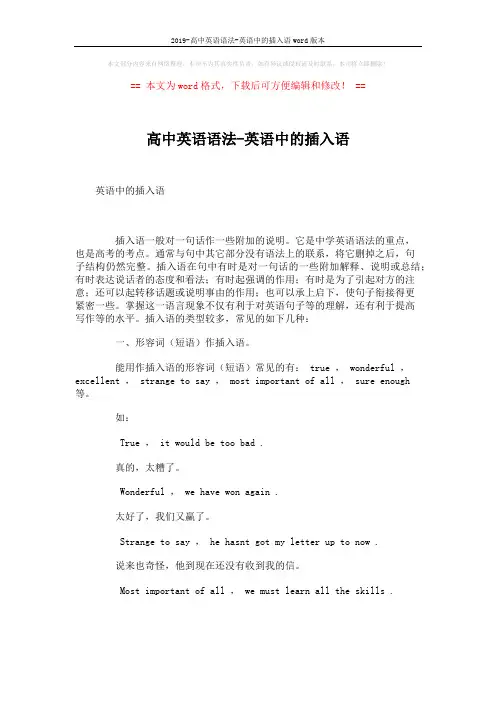
2019-高中英语语法-英语中的插入语word版本
本文部分内容来自网络整理,本司不为其真实性负责,如有异议或侵权请及时联系,本司将立即删除!
== 本文为word格式,下载后可方便编辑和修改! ==
高中英语语法-英语中的插入语
英语中的插入语
插入语一般对一句话作一些附加的说明。
它是中学英语语法的重点,
也是高考的考点。
通常与句中其它部分没有语法上的联系,将它删掉之后,句
子结构仍然完整。
插入语在句中有时是对一句话的一些附加解释、说明或总结;有时表达说话者的态度和看法;有时起强调的作用;有时是为了引起对方的注意;还可以起转移话题或说明事由的作用;也可以承上启下,使句子衔接得更
紧密一些。
掌握这一语言现象不仅有利于对英语句子等的理解,还有利于提高
写作等的水平。
插入语的类型较多,常见的如下几种:
一、形容词(短语)作插入语。
能用作插入语的形容词(短语)常见的有: true , wonderful ,excellent , strange to say , most important of all , sure enough 等。
如:
True , it would be too bad .
真的,太糟了。
Wonderful , we have won again .
太好了,我们又赢了。
Strange to say , he hasnt got my letter up to now .
说来也奇怪,他到现在还没有收到我的信。
Most important of all , we must learn all the skills .。
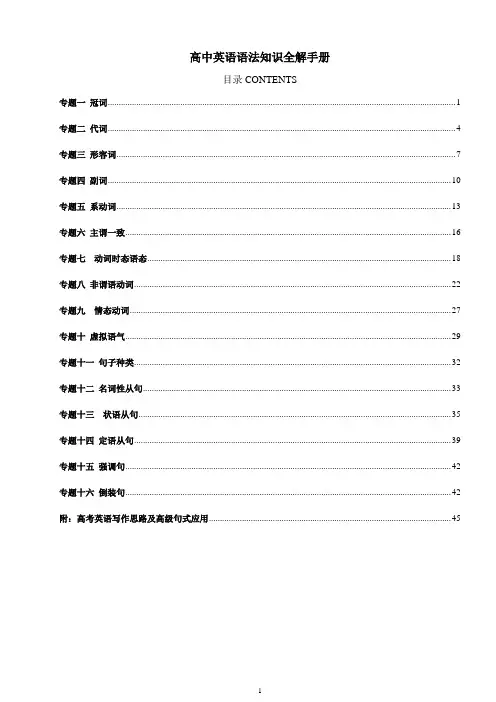
高中英语语法知识全解手册目录CONTENTS专题一冠词 (1)专题二代词 (4)专题三形容词 (7)专题四副词 (10)专题五系动词 (13)专题六主谓一致 (16)专题七动词时态语态 (18)专题八非谓语动词 (22)专题九情态动词 (27)专题十虚拟语气 (29)专题十一句子种类 (32)专题十二名词性从句 (33)专题十三状语从句 (35)专题十四定语从句 (39)专题十五强调句 (42)专题十六倒装句 (42)附:高考英语写作思路及高级句式应用 (45)12专题一冠词冠词作为一种虚词,在英语中只能和名词一起使用。
英语中的冠词分为不定冠词.定冠词和零冠词。
1.不定冠词的用法不定冠词表示泛指,指首次提到的不限定的人或事物。
不定冠词有两个,a 和an. a用在辅音开头的单词前面;an用于以元音开头的单词前。
如:a book, an apple.1) 第一次提到的人或事物There is a new handbag on the desk. I bought the handbag yesterday.2) 泛指同类中的某一(人/ 物)A Mr. Smith came to see you while you were away.I remember he came here on a Saturday and left soon.3) 一类,表示类别A doctor is a person who saves people’s lives.A horse is a useful animal.4) 表频度,译为“每一”相当于per/ every/ each5) 时间.速度.价格等词之前We have ten English lessons a week.A spaceship flies about 11 kilometers a second.These envelopes are two yuan a dozen.6) 序数词前,“又一,再一”most前, most=veryYou must try a second time.Suzhou is a most beautiful city in China.7) “一杯.一份.一场”等数量概念,用于物质名词前A heavy rain fell this morning in this small town.I would like a coffee and two beers.8) 一个具体的人或物,用于抽象名词前Studying with you is a great pleasure.As a teacher, his father is a success, but as a poet, he is a failure.9) 表某一方面.某一部分等特殊含义,用于不可数名词前She has a good knowledge of English and computer.1He has had a good education.10) “一”的概念,相当于one.A hundred people are invited to the party.There is going to be an English lecture this evening.It is a foot long, an inch thick.11) 动作意义的名词前have a walk/ look/ break/ try/ bath/ swimhave a cold/ cough/ fever/ headache/ painhave a good/ happy time take a rest/ walk/ break/ bath/ trygive a smile/ laugh/ shout make an effort to domake a choice/ decision/ plan/ face / mistake/ promise/ speech/ living12) 固定搭配as a rule 作为常规as a result 结果in a word 总之at a loss 不知所措all of a sudden 突然in a hurry 匆忙地in a way从某种意义上说once in a while 时而a moment ago 刚才as a matter of fact 事实上after a while 一会儿后at a high speed 以很高的速度once upon a time 从前2. 定冠词的用法1)定冠词和名词连用,表示某个或某些特定的人或东西。
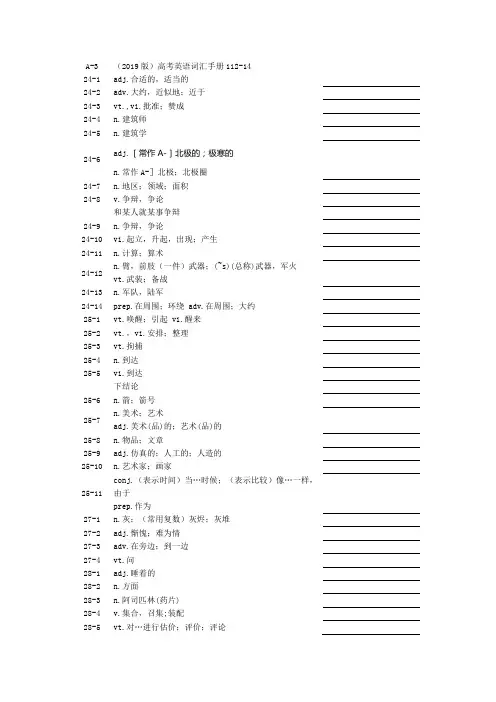
A-3 (2019版)高考英语词汇手册112-14 24-1 adj.合适的,适当的24-2 adv.大约,近似地;近于24-3 vt.,vi.批准;赞成24-4 n.建筑师24-5 n.建筑学24-6adj.[常作A-]北极的;极寒的n.常作A-]北极;北极圈24-7 n.地区;领域;面积24-8 v.争辩,争论和某人就某事争辩24-9 n.争辩,争论24-10 vi.起立,升起,出现;产生24-11 n.计算;算术24-12 n.臂,前肢(一件)武器;(~s)(总称)武器,军火vt.武装;备战24-13 n.军队,陆军24-14 prep.在周围;环绕 adv.在周围;大约25-1 vt.唤醒;引起 vi.醒来25-2 vt.,vi.安排;整理25-3 vt.拘捕25-4 n.到达25-5 vi.到达下结论25-6 n.箭;箭号25-7 n.美术;艺术adj.美术(品)的;艺术(品)的25-8 n.物品;文章25-9 adj.仿真的;人工的;人造的25-10 n.艺术家;画家25-11 conj.(表示时间)当…时候;(表示比较)像…一样,由于prep.作为27-1 n.灰;(常用复数)灰烬;灰堆27-2 adj.惭愧;难为情27-3 adv.在旁边;到一边27-4 vt.问28-1 adj.睡着的28-2 n.方面28-3 n.阿司匹林(药片)28-4 v.集合,召集;装配28-5 vt.对…进行估价;评价;评论28-6 vt.分配;布置;指派28-7 v.协助,帮助28-8 n.助手28-9 vt.结合在一起;使有联系28-10 n.联合;联盟;协会;社团29-1 vt.假定;承担29-2 vt.使(某人)相信29-3 vt.使惊讶29-4 n.宇航员29-5 prep.在……29-6 n.运动员;(英)田径运动员29-7 adj.运动员的;运动的29-8 n.大西洋 adj.大西洋的29-9 n.大气;气氛30-1 n.原子30-2 vt.连接;使依附 vi.附属30-3 vt.攻击;侵害30-4 n.,vt.企图,尝试30-5 vt.,vi.出席,参加30-6 n.注意30-7 n.态度;看法31-1 vt.吸引;引起31-2 n.听众;观众31-3 adj.视听的31-4 n.姨;姑;婶母;舅母31-5 n.作者31-6 n.权力;权威31-7 n.汽车(autonobile的缩略)31-8 adj.自动地31-9 n.秋天,秋季31-10 adj.可取得的,可采用的31-11 n.林荫道;(南北向)街31-12 adj.中等的;平常的,平均的vt.算出…的平均数;将…平均分配;使…平衡vi.平均为32-1 vt.避免32-2 vt.等假;等待(处理)32-3 adj.醒着的32-4 v.唤醒嘈杂的声音把孩子闹醒了。
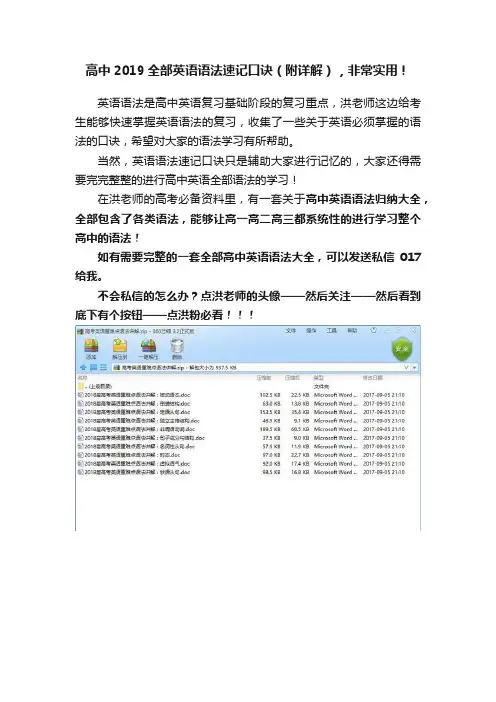
高中2019全部英语语法速记口诀(附详解),非常实用!
英语语法是高中英语复习基础阶段的复习重点,洪老师这边给考生能够快速掌握英语语法的复习,收集了一些关于英语必须掌握的语法的口诀,希望对大家的语法学习有所帮助。
当然,英语语法速记口诀只是辅助大家进行记忆的,大家还得需要完完整整的进行高中英语全部语法的学习!
在洪老师的高考必备资料里,有一套关于高中英语语法归纳大全,全部包含了各类语法,能够让高一高二高三都系统性的进行学习整个高中的语法!
如有需要完整的一套全部高中英语语法大全,可以发送私信017给我。
不会私信的怎么办?点洪老师的头像——然后关注——然后看到底下有个按钮——点洪粉必看
好了。
下面是各类非常实用的英语语法速记口诀!。
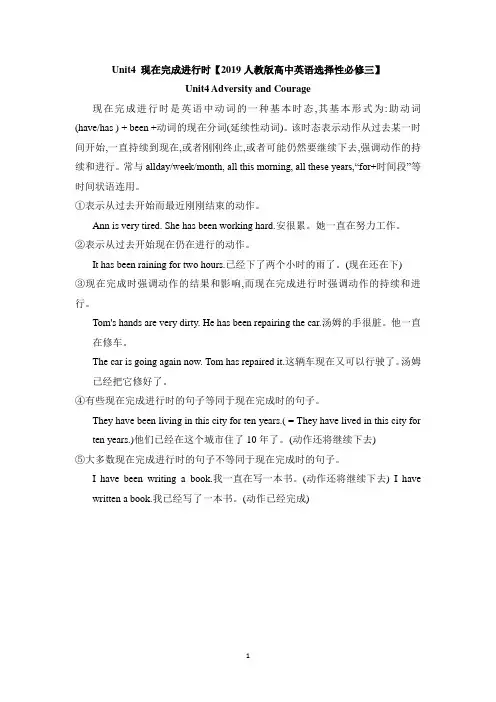
Unit4 现在完成进行时【2019人教版高中英语选择性必修三】Unit4 Adversity and Courage现在完成进行时是英语中动词的一种基本时态,其基本形式为:助动词(have/has ) + been +动词的现在分词(延续性动词)。
该时态表示动作从过去某一时间开始,一直持续到现在,或者刚刚终止,或者可能仍然要继续下去,强调动作的持续和进行。
常与allday/week/month, all this morning, all these years,“for+时间段”等时间状语连用。
①表示从过去开始而最近刚刚结束的动作。
Ann is very tired. She has been working hard.安很累。
她一直在努力工作。
②表示从过去开始现在仍在进行的动作。
It has been raining for two hours.已经下了两个小时的雨了。
(现在还在下)③现在完成时强调动作的结果和影响,而现在完成进行时强调动作的持续和进行。
Tom's hands are very dirty. He has been repairing the car.汤姆的手很脏。
他一直在修车。
The car is going again now. Tom has repaired it.这辆车现在又可以行驶了。
汤姆已经把它修好了。
④有些现在完成进行时的句子等同于现在完成时的句子。
They have been living in this city for ten years.( = They have lived in this city for ten years.)他们已经在这个城市住了10年了。
(动作还将继续下去)⑤大多数现在完成进行时的句子不等同于现在完成时的句子。
I have been writing a book.我一直在写一本书。
(动作还将继续下去) I havewritten a book.我已经写了一本书。
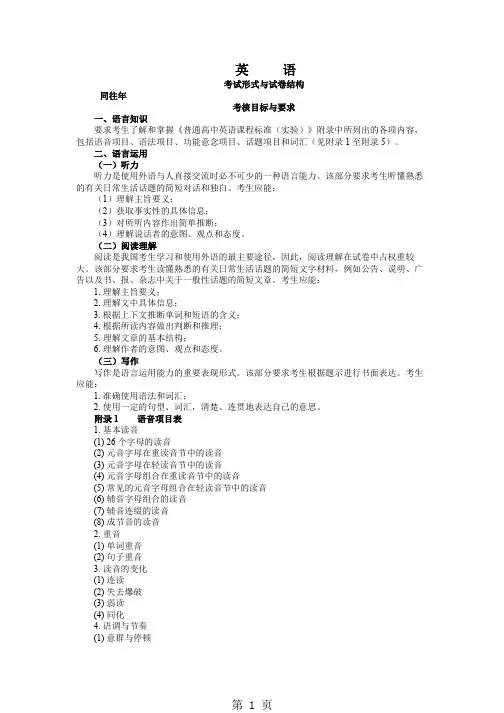
英语考试形式与试卷结构同往年考核目标与要求一、语言知识要求考生了解和掌握《普通高中英语课程标准(实验)》附录中所列出的各项内容,包括语音项目、语法项目、功能意念项目、话题项目和词汇(见附录 1 至附录 5)。
二、语言运用(一)听力听力是使用外语与人直接交流时必不可少的一种语言能力。
该部分要求考生听懂熟悉的有关日常生活话题的简短对话和独白。
考生应能:(1)理解主旨要义;(2)获取事实性的具体信息;(3)对所听内容作出简单推断;(4)理解说话者的意图、观点和态度。
(二)阅读理解阅读是我国考生学习和使用外语的最主要途径,因此,阅读理解在试卷中占权重较大。
该部分要求考生读懂熟悉的有关日常生活话题的简短文字材料,例如公告、说明、广告以及书、报、杂志中关于一般性话题的简短文章。
考生应能:1. 理解主旨要义;2. 理解文中具体信息;3. 根据上下文推断单词和短语的含义;4. 根据所读内容做出判断和推理;5. 理解文章的基本结构;6. 理解作者的意图、观点和态度。
(三)写作写作是语言运用能力的重要表现形式。
该部分要求考生根据题示进行书面表达。
考生应能:1. 准确使用语法和词汇;2. 使用一定的句型、词汇,清楚、连贯地表达自己的意思。
附录 1语音项目表1. 基本读音(1)26 个字母的读音(2)元音字母在重读音节中的读音(3)元音字母在轻读音节中的读音(4)元音字母组合在重读音节中的读音(5)常见的元音字母组合在轻读音节中的读音(6)辅音字母组合的读音(7)辅音连缀的读音(8)成节音的读音2. 重音(1)单词重音(2)句子重音3. 读音的变化(1)连读(2)失去爆破(3)弱读(4)同化4. 语调与节奏(1)意群与停顿(3)节奏5.语音、语调、重音、节奏等在口语交流中的运用6.朗诵和演讲中的语音技巧7.主要英语国家的英语语音差异附录 2语法项目表1. 名词(1)可数名词及其单复数(2)不可数名词(3)专有名词(4)名词所有格2. 代词(1)人称代词(2)物主代词(3)反身代词(4)指示代词(5)不定代词(6)疑问代词3. 数词(1)基数词(2)序数词4.介词和介词短语5.连词6.形容词(比较级和最高级)7.副词(比较级和最高级)8.冠词9.动词(1)动词的基本形式(2)系动词(3)及物动词和不及物动词(4)助动词(5)情态动词10. 时态(1)一般现在时(2)一般过去时(3)一般将来时(4)现在进行时(5)过去进行时(6)过去将来时(7)将来进行时(8)现在完成时(9)过去完成时(10)现在完成进行时11.被动语态12.非谓语动词(1)动词不定式(2)动词的-ing 形式(3)动词的-ed 形式13. 构词法(1)合成法(2)派生法(4)缩写和简写14. 句子种类(1)陈述句(2)疑问句(3)祈使句(4)感叹句15. 句子成分(1)主语(2)谓语(3)表语(4)宾语(5)定语(6)状语(7)补语16.简单句的基本句型17.主谓一致18.并列复合句19.主从复合句(1)宾语从句(2)状语从句(3)定语从句(4)主语从句(5)表语从句20.间接引语21.省略22.倒装23.强调24.虚拟语气附录 3功能意念项目表1.社会交往 (Social Communications)(1) 问候 (Greetings)(2) 介绍 (Introduction)(3) 告别 (Farewells )(4) 感谢 (Thanks )(5) 道歉 (Apologies)(6) 邀请 (Invitation)(7) 请求允许 (Asking for permission)(8) 祝愿和祝贺 (Expressing wishes and congratulations)(9) 提供帮助 (Offering help)(10) 接受和拒绝 (Acceptance and refusal)(11) 约会 (Making appointments)(12) 打电话 (Making telephone calls)(13) 就餐 (Having meals)(14) 就医 (Seeing the doctor)(15) 购物 (Shopping)(16) 问路 (Asking the way)(17) 谈论天气 (Talking about weather)(18) 语言交际困难 (Language difficulties in communication)(19) 提醒注意 (Reminding)(20) 警告和禁止 (Warning and prohibition)(21) 劝告 (Advice)(22) 建议 (Suggestions)2.态度 (Attitudes)(23)同意和不同意 (Agreement and disagreement)(24)喜欢和不喜欢 (Likes and dislikes)(25)肯定和不肯定 (Certainty and uncertainty)(26)可能和不可能 (Possibility and impossibility)(27)能够和不能够 (Ability and inability)(28)偏爱和优先选择 (Preference)(29)意愿和打算 (Intentions and plans)(30)希望和愿望 (Hopes and wishes)(31)表扬和鼓励 (Praise and encouragement)(32)责备和抱怨 (Blame and complaint)(33)冷淡 (Indifference)(34)判断与评价 (Judgement and evaluation) 3. 情感 (Emotions)(35)高兴 (Happiness)(36)惊奇 (Surprise)(37)忧虑 (Worries)(38)安慰 (Reassurance)(39)满意 (Satisfaction)(40)遗憾 (Regret)(41)同情 (Sympathy)(42)恐惧 (Fear)(43)愤怒 (Anger)4. 时间 (Time)(44) 时刻 (Point of time)(45)时段 (Duration)(46)频度 (Frequency)(47)时序 (Sequence) 5. 空间 (Space)(48)位置 (Position)(49)方向 (Direction)(50)距离 (Distance) 6. 存在 (Existence)(51)存在与不存在 (Existence and Non-existence) 7. 特征 (Features)(52)形状 (Shape)(53)颜色 (Colour)(54)材料 (Material)(55)价格 (Price)(56)规格 (Size)(57)年龄 (Age)8. 计量 (Measurement)(58)长度 (Length)(59)宽度 (Width)(60)高度 (Height)(61)数量 (Number) 9. 比较 (Comparison)(62)同级比较 (Equal comparison)(63)差别比较 (Comparative and superlative)(64)相似和差别 (Similarity and difference) 10. 逻辑关系 (Logical relations)(65)原因和结果 (Cause and effect)(66)目的 (Purpose)11. 职业 (Occupations)(67)工作 (Jobs)(68)单位 (Employer)附录 4话题项目表1.个人情况 (Personal information)2.家庭、朋友与周围的人 (Family, friends and people around)3.周围的环境 (Personal environments)4.日常活动 (Daily routines)5.学校生活 (School life)6.兴趣与爱好 (Interests and hobbies)7.个人感情 (Emotions)8.人际关系 (Interpersonal relationships)9.计划与愿望 (Plans and intentions)10.节假日活动 (Festivals, holidays and celebrations)11.购物 (Shopping)12.饮食 (Food and drink)13.健康 (Health)14.天气 (Weather)15.文娱与体育 (Entertainment and sports)16.旅游和交通 (Travel and transport)17.语言学习 (Language learning)18.自然 (Nature)19.世界与环境 (The world and the environment)20.科普知识与现代技术 (Popular science and modern technology)21.热点话题 (Topical issues)22.历史与地理 (History and geography)23.社会 (Society)24.文学与艺术 (Literature and art)附录 5 词汇表Aa(an) art abandon vability nable aabnormal a aboard prep abolish vabortion nabout ad & prep above prep,a & ad abroad adabrupt a absence nabsent a absolute a absorb vabstract a & n absurd a abundant a abuse v academic a & n academy n accelerate v accent naccept vaccess n & v accessible a accident n accommodation n accompany v accomplish v account n accountant n accumulate v accuracy n accurate aaccuse v accustomed a ache v & n achieve v achievement n acid a acknowledge v acquaintance n acquire v acquisition nacre nacross prepact n & vaction nactive aactivity nactor nactress nactual a acute aAD abbrad=advertisement n adapt vadaptation nadd vaddicted aaddition naddress n adequate aadjust v adjustment n administration n admirable aadmire v admission nadmit v adolescence n adolescent a & n adopt vadore vadult nadvance v & n advantage n adventure n advertise v advertisement n advice nadvise vadvocate vaffair naffect vaffection nafford vafraid aAfrica nAfrican a & nafter ad,prep & conj afternoon n afterward(s) ad again adagainst prepage nagency nagenda nagent n aggressive aago adagree v agreement n agricultural a agriculture nahead adaid n & vAIDS naim n & vair naircraft nairline nairmail nairplane nairport nairspace nalarm n & valbum nalcohol nalcoholic a & n algebra nalike adalive aall ad,a & pron allergic aalley nallocate vallow vallowance nalmost adalone aalong ad & prep alongside adaloud adalphabet nalready adalso adalternative aalthough conjaltitude naltogether ad aluminium(Am aluminum) n always adam v(be)a.m./am,A.M./AM abbr amateur aamaze vamazing a ambassador n ambassadress n ambiguous aambition n ambulance nAmerica namong prepamount n & vample aamuse vamusement nanalyse vanalysis nancestor nanchor v & nancient aand conj anecdote n anger nangle nangry aanimal nankle n anniversary n announce v annoy vannual a another a & pron answer n & vant nAntarctic a antique n anxiety n anxious aany pron & a anybody pron anyhow ad anyone pron anything pron anyway ad anywhere ad apart ad & a apartment n apologize v apology n apparent a appeal v & n appear v appearance n appendix n appetite n applaud v & n apple n applicant n application n apply vappoint v appointment n appreciate v appreciation n approach n & v appropriate a approval n approve v approximately ad apron narbitrary aarch narchitect n architecture n Arctic aare v(be)area nargue vargument narise(arose,arisen) v arithmetic narm n & v armchair narmy naround ad & prep arrange v arrangement n arrest varrival narrive varrow nart narticle nartificial aartist nas ad,conj & prep ash nashamed aAsia nAsian a & naside adask vasleep aaspect nassess v assessment n assist v assistance n assistant n associate v association n assume v assumption n astonish v astronaut n astronomer n astronomy nat prepathlete nathletic aAtlantic a atmosphere natom nattach vattack v & nattain vattempt v & n attend vattention nattitude nattract vattraction n attractive a audience naunt n authentic aauthor nauthority nautomatic aautonomous aautumn navailable aavenue naverage a & navoid vawake(awoke,awoken) v & a award naware aaway adawesome aawful aawkward aBbaby nbachelor nback ad,a & nbackground nbackward(s) adbacon nbacterium(pl bacteria) n bad(worse,worst) a badminton nbag nbaggage nbakery nbalance nbalcony nball nballet nballoon nbamboo nban n & vbanana nband nbandage nbank nbar nbarbecue nbarber nbarbershop nbare abargain n & vbark v & nbarrier nbase nbaseball nbasement nbasic abasin nbasis nbasket nbasketball nbat nbath nbathe vbathroom nbathtub nbattery nbattle nbay nBC abbrbe(am,is,are,was, were,being,been) v beach nbean nbean curd nbear1 nbear2 vbeard nbeast nbeat(beat,beaten) v & nbeautiful abeauty nbecause conjbecome(became,become) vbed nbeddings nbedroom nbee nbeef nbeer nbefore prep,ad&conjbeg vbegin(began,begun) vbehalf nbehave vbehaviour(Am behavior) n behind prep & adbeing nbelief nbelieve vbell nbelly nbelong vbelow prepbelt nbench nbend(bent,bent) vbeneath prepbeneficial abenefit n & vbent a & nbeside prepbesides prep & adbetray vbetween prepbeyond prepbicycle nbid v & nbig a bike=bicycle nbill nbingo n biochemistry n biography n biology nbird nbirth nbirthday n birthplace nbiscuit nbishop nbit nbite(bit,bitten) v bitter ablack a & n blackboard nblame n & vblank n & a blanket nbleed vbless vblind ablock n & vblood nblouse nblow(blew,blown) v blue n & aboard n & vboat nbody nboil vbomb n & vbond n & vbone nbonus nbook n & vboom n & vboot nbooth nborder nbored aboring aborn aborrow vboss nbotanical abotany nboth a & pron bother vbottle nbottom nbounce vbound aboundary nbow v & nbowl nbowling nbox nboxing nboy nboycott vbrain nbrake n & vbranch nbrand nbrave abravery nbread nbreak(broke,broken) v & nbreakfast nbreakthrough nbreast nbreath nbreathe vbreathless abrewery nbrick nbride nbridegroom nbridge nbrief abright abrilliant abring(brought,brought) vbroad abroadcast(broadcast,broadcast 或-ed,-ed) vbrochure nbroken abroom nbrother nbrown n & abrunch nbrush v & nBuddhism nbudget nbuffet nbuild(built,built) vbuilding nbunch nbungalow nburden nbureaucratic aburglar nburn(burnt,burnt 或-ed,-ed) v & nburst vbury vbus nbush nbusiness nbusinessman/woman (pl businessmen/ women) nbusy a but conj & prepbutcher n & vbutter nbutterfly nbutton n & vbuy(bought,bought) vby prepbye intCcab ncabbage ncafe ncafeteria ncage ncake ncalculate vcall n & vcalm a & vcamel ncamera ncamp n & vcampaign ncan1(could); can’t=cannot modal v can2 ncanal ncancel vcancer ncandidate ncandle ncandy ncanteen ncap ncapital ncapsule ncaptain ncaption ncar ncarbon ncard ncare n & vcareful acareless acarpenter ncarpet ncarriage ncarrier ncarrot ncarry vcartoon ncarve vcase ncash n & vcassette ncast(cast,cast) vcastle ncasual acat ncatalogue ncatastrophe ncatch(caught,caught) vcategory ncater vCatholic acattle ncause n & vcaution ncautious acave nCD=compact disk nceiling ncelebrate vcelebration ncell ncent ncentigrade acentimetre (Am centimeter) ncentral acentre(Am center) ncentury nceremony ncertain acertificate nchain nchair nchairman/woman (pl chairmen/women) n chalk nchallenge nchallenging achampion nchance nchange n & vchangeable achannel nchant v & nchaos nchapter ncharacter ncharacteristic a & ncharge v & nchart nchat n & vcheap acheat n & vcheck n & vcheek ncheer n & vcheerful acheers intcheese nchef nchemical a & nchemist nchemistry ncheque(Am check) n chess nchest nchew vchicken nchief a & nchild(pl children) n childhood nchocolate nchoice nchoir nchoke n & vchoose(chose,chosen) v chopsticks nchorus nChristian nChristmas nchurch ncigar ncigarette ncinema ncircle n & vcircuit ncirculate v circumstance ncircus ncitizen ncity ncivil acivilian ncivilization nclap vclarify vclass nclassic aclassify vclassmate nclassroom nclaw nclay nclean v & acleaner nclear aclerk nclever aclick vclimate nclimb vclinic nclock nclone vclose a & adcloth nclothes nclothing ncloud ncloudy aclub nclumsy acoach ncoal ncoast ncoat ncocoa ncoffee ncoin ncoincidence ncoke ncold a & ncollar ncolleague ncollect vcollection ncollege ncollision ncolour(Am color) n & v comb n & vcombine vcome(came,come) v comedy ncomfort n comfortable a command n & v comment n commercial acommit v commitment n committee n common a communicate v communication n communism n communist n & a companion n company ncompare vcompass n compensate v compete v competence n competition n complete a & v complex a & n component n composition n comprehension n compromise v compulsory a computer n concentrate vconcept nconcern v & nconcert nconclude v conclusion n concrete a condemn v condition n conduct v conductor n conference n confident a confidential a confirm v conflict n confuse v congratulate v congratulation n connect v connection n conscience n consensus n consequence n conservation n conservative a consider v considerate a consideration n consist v consistent a constant a constitution n construct v construction n consult v consultant n consume v contain v container n contemporary a content1 n content2 a continent n continue v contradict v contradictory a contrary n & a contribute v contribution n control v & n controversial a convenience n convenient a conventional a conversation n convey v convince v cook n & v cooker n cookie ncool acopy n & vcorn ncorner n corporation n correct v & a correction n correspond v corrupt a & vcost n & vcosy(Am cozy) a cottage ncotton n & acough n & vcould modal v count vcounter ncountry n countryside n couple ncourage ncourse ncourt ncourtyard ncousin ncover n & vcow ncrash v & ncrayon ncrazy acream ncreate vcreature ncredit ncrew ncrime ncriminal ncriterion(pl criteria) n crop ncross n & v crossing n crossroads ncrowd n & vcruel acry n & vcube ncubic acuisine nculture ncup ncupboard ncure n & vcurious acurrency n curriculum ncurtain ncushion ncustom ncustomer n customs ncut(cut,cut) v & n cycle vcyclist nDdad=daddy ndaily a,ad & ndam ndamage n & vdamp a & ndance n & vdanger ndangerous adare v & modal vdark a & ndarkness ndash v & ndata ndatabase ndate n & vdaughter ndawn nday ndead adeadline ndeaf adeal ndear adeath ndebate n & vdebt ndecade ndecide vdecision ndeclare vdecline vdecorate vdecoration n decrease vdeed ndeep a & addeer ndefeat vdefence(Am defense) n defend vdegree ndelay n & vdelete v & n deliberately ad delicate adelicious adelight ndelighted adeliver vdemand vdentist n department(Dept.) ndeparture ndepend vdeposit v & ndepth ndescribe v description ndesert v & ndeserve vdesign v & ndesire v & ndesk ndesperate adessert ndestination ndestroy vdetective n determine vdevelop v development n devote vdevotion ndiagram ndial vdialogue(Am dialog) n diamond ndiary ndictation ndictionary ndie vdiet ndiffer vdifference ndifferent adifficult adifficulty ndig(dug,dug) vdigest vdigital adignity ndilemma n dimension ndinner ndinosaur ndioxide ndip vdiploma ndirect a & vdirection ndirector ndirectory ndirty adisability ndisabled a disadvantage n disagree v disagreement n disappear v disappoint v disappointed a disaster ndiscount n discourage v discover v discovery n discrimination n discuss v discussion n disease n disgusting adish ndisk=disc ndislike vdismiss vdistance ndistant adistinction n distinguish v distribute vdistrict ndisturb vdisturbing adive vdiverse adivide vdivision ndivorce vdizzy ado(did,done) v doctor ndocument ndog ndoll ndollar ndonate vdoor ndormitory(dorm) n dot ndouble a & ndoubt n & vdown prep & ad download n & v downstairs ad downtown ad,n & a dozen nDr=doctor ndraft n & vdrag vdraw(drew,drawn) v drawback ndrawer ndream(dreamt,dreamt 或-ed,-ed) n & v dress n & vdrill n & vdrink(drank,drunk) vdrive(drove,driven) vdriver ndrop n & vdrug ndrum ndrunk adry v & aduck ndue adull adumpling nduring prepdusk ndust ndustbin ndusty aduty nDVD=digital versatile disk n dynamic adynasty nEeach a & proneager aeagle near nearly a & adearn vearth nearthquake neast a,ad & nEaster neastern aeasy aeat(ate,eaten) vecology nedge nedition neditor neducate veducation neducator neffect neffort negg neggplant neither a,conj & adelder nelect velectric aelectrical aelectricity nelectronic aelegant aelephant nelse ade-mail n & v embarrass v embassy n emergency n emperor n employ vempty a encourage v encouragement n end n & v ending nendless aenemy n energetic a energy nengine n engineer nenjoy v enjoyable a enlarge venough pron,a & ad enquiry nenter v enterprise n entertainment n enthusiastic a entire aentrance nentry nenvelope n environment n envy v & nequal a & v equality nequip v equipment n eraser nerror nerupt vescape n & v especially ad essay nEurope n European a & n evaluate veven adevening nevent n eventually ad ever adevery a everybody pron everyday a everyone pron everything pron everywhere ad evidence n evident aevolution nexact aexam=examination n examine vexample n excellent aexcept prep exchange n & v excite vexcuse n & v exercise n & v exhibition nexist vexistence nexit nexpand vexpect v expectation n expense n expensive a experience n experiment nexpert nexplain v explanation n explicit aexplode vexplore vexport n & v expose vexpress v & n expression n extension nextra a extraordinary a extreme aeye neyesight nFface n & vfacial afact nfactory nfade vfail v & nfailure nfair1 afair2 nfaith nfall1(fell,fallen) vfall2(Am)=autumn n false afamiliar afamily nfamous afan nfancy n,v & a fantastic afantasy nfar(farther,farthest或 further,furthest) a & ad fare nfarm nfarmer nfast a & adfasten vfat n & afather nfault nfavour(Am favor) n favourite(Am favorite) a & n fax n & vfear nfeast nfeather nfederal afee nfeed(fed,fed) vfeel(felt,felt) vfeeling nfellow nfemale a & nfence nferry nfestival n & afetch vfever nfew pron & afibre(Am fiber) nfiction nfield nfierce afight(fought,fought) n & v figure n & vfile nfill vfilm n & vfinal afinance nfind(found,found) vfine1 afine2 vfinger nfingernail nfinish v & nfire n & vfireworks nfirm1 nfirm2 afish n & vfisherman nfist nfit a & vfix vflag nflame nflash nflashlight nflat1 aflat2 nflee(fled,fled) vflesh nflexible aflight nfloat vflood n & vfloor nflour nflow vflower nflu nfluency nfluent afly1(flew,flown) vfly2 nfocus v & nfog nfoggy afold vfolk n & afollow vfond afood nfool n & vfoolish afoot(pl feet) nfootball nfor prep & conjforbid(forbade,forbidden) v force vforecast n & vforehead nforeign aforeigner nforesee(foresaw,foreseen) v forest nforever adforget(forgot,forgot/forgotten) v forgetful aforgive(forgave,forgiven) vfork nform n & vformat nformer afortnight nfortunate afortune nforward adfoster vfound vfountain n funeral n fox nfragile afragrant a framework nfranc nfree afreedom nfreeway nfreeze(froze,frozen) v freezing afrequent afresh afriction nfridge=refrigerator n friend nfriendly a friendship nfrighten vfrog nfrom prepfront a & nfrontier nfrost nfruit nfry vfuel nfull afun n & afunction n & v fundamental a funny afur nfurnished afurniture nfuture nGgain vgallery ngallon ngame ngarage ngarbage ngarden ngarlic ngarment ngas ngate ngather vgay ageneral a & n generation n generous agentle agentleman n geography n geometry ngesture nget(got,got) vgift ngifted agiraffe ngirl ngive(gave,given) v glad aglance vglare vglass nglobe nglory nglove nglue ngo(went,gone) vgoal ngoat ngod ngold n & agolden agolf ngood(better,best) a goods ngoose(pl geese) n govern v government ngrade ngradual agraduate v graduation ngrain ngram ngrammar ngrand agrandchild n granddaughter n grandma=grandmother n grandpa=grandfather n grandparents n grandson ngranny ngrape ngraph ngrasp vgrass ngrateful agravity ngreat a & adgreedy agreen a & n greengrocer ngreet vgreeting ngrey(Am gray) agrill ngrocer ngrocery n ground ngroup ngrow(grew,grown) vgrowth nguarantee vguard nguess vguest nguidance nguide nguilty aguitar ngun ngym=gymnasium n gymnastics nHhabit nhair nhaircut nhalf a & nhall nham nhamburger nhammer nhand n & vhandbag nhandful nhandkerchief nhandle n & vhandsome ahandwriting nhandy ahang(hung,hung 或-ed,-ed) v happen vhappiness nhappy aharbour(Am harbor) nhard ad & ahardly adhardship nhardworking aharm n & vharmful aharmony nharvest n & vhat nhatch vhate v & nhave(has,had,had) vhe pronhead n & vheadache nheadline nheadmaster n headmistress nhealth nhealthy ahear(heard,heard) v hearing nheart nheat nheaven nheavy aheel nheight nhelicopter nhello inthelmet nhelp n & vhelpful ahen nher pronherb nhere adhero nhers pronherself pronhesitate vhi inthide(hid,hidden) v high a & adhighway nhill nhim pronhimself pronhire vhis pronhistory nhit(hit,hit) v & n hobby nhold(held,held) v hole nholiday nholy ahome n & ad homeland n hometown n homework nhonest ahoney nhonour(Am honor) n & v hook n & vhope n & vhopeful ahopeless ahorrible ahorse nhospital nhost n & vhostess nhot ahotdog nhotel nhour n house nhousewife n housework nhow adhowever ad & conj howl vhug vhuge ahuman a & nhuman being n humorous ahumour(Am humor) n hunger nhungry ahunt vhunter nhurricane nhurry vhurt(hurt,hurt) v husband nhydrogen nII pronice nice-cream nidea nidentity n identification nidiom nif conjignore vill aillegal aillness nimagine v immediately ad immigration nimport v & n importance n important a impossible a impress v impression n improve vin prep & adinch nincident ninclude vincome nincrease v & n indeed a independence n independent a indicate vindustry ninfluence n & v inform vinformation ninitial ainjure vinjury nink ninn ninnocent ainsect ninsert vinside prep & adinsist vinspect vinspire vinstant ainstead adinstitute ninstitution ninstruct vinstruction n instrument n insurance ninsure vintelligence nintend vintention ninterest ninteresting a international aInternet ninterpreter ninterrupt vinterval ninterview n & vinto prepintroduce v introduction ninvent vinvention ninvitation ninvite viron n & virrigation nis v(be)island nit pronits pronitself pronJjacket njam njar njaw njazz njeans njeep njet njewellery(Am jewelry) n job njog vjoin vjoke njournalist njourney njoy njudge n & vjudgement(Am judgment) njuice njump n & vjungle njunior ajust a & adjustice nKkangaroo nkeep(kept,kept) vkettle nkey nkeyboard nkick v & nkid nkill vkilo nkilogram nkilometre(Am kilometer) n kind1 nkind2 akindergarten nkindness nking nkingdom nkiss n & vkitchen nkite nknee nknife(pl knives) nknock n & vknow(knew,known) v knowledge nLlab=laboratory nlabour(Am labor) nlack n & vlady nlake nlamb nlame alamp nland n & vlanguage nlantern nlap nlarge alast a & v。
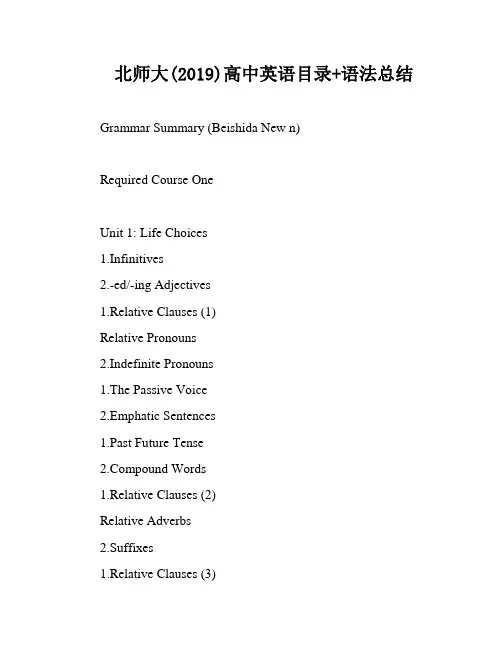
北师大(2019)高中英语目录+语法总结Grammar Summary (Beishida New n)Required Course OneUnit 1: Life Choices1.Infinitives2.-ed/-ing Adjectives1.Relative Clauses (1)Relative Pronouns2.Indefinite Pronouns1.The Passive Voice2.Emphatic Sentences1.Past Future Tensepound Words1.Relative Clauses (2)Relative Adverbs2.Suffixes1.Relative Clauses (3)ns + Which/Whom2.Synonyms and Antonyms1.Noun Clauses1.Verb -ing and -ed Forms1.Verbs Followed by Verb Forms or Infinitives2.Subject-Verb AgreementUnit 2: Sports and FitnessNo grammar points listed.Unit 3: nsNo grammar points listed.Required Course TwoUnit 4: n TechnologyNo grammar points listed.Unit 5: Humans and NatureNo grammar points listed.Unit 6: The Admirable No grammar points listed.Required Course ThreeUnit 7: ArtNo grammar points listed.Unit 8: Green LivingNo grammar points listed.Unit 9: LearningNo grammar points listed.Elective Course OneUnit 1: nships1.Past Perfect Tense1.Verb -ing Form2.Articles1.Relative Clauses (4)Defining and Non-defining Relative Clauses限制性和非限制性定语从句Defining relative clauses are used to identify or specify a particular person or thing in a sentence。
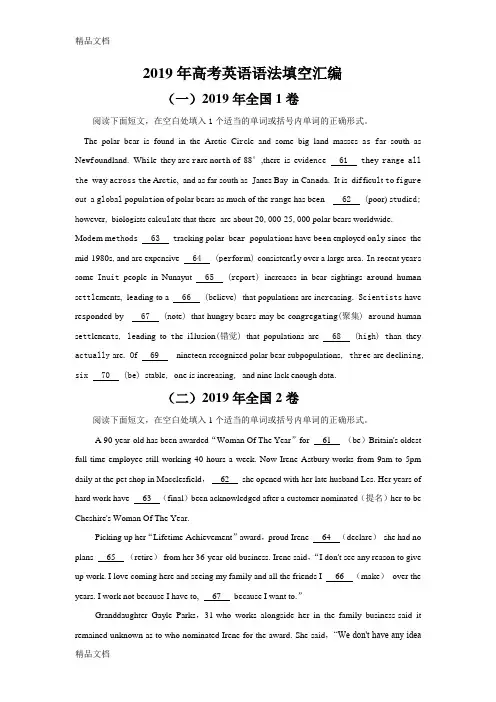
2019年高考英语语法填空汇编(一)2019年全国1卷阅读下面短文,在空白处填入1个适当的单词或括号内单词的正确形式。
The polar bear is found in the Arctic Ci r cle and some big land masses a s f ar south as N ewf oundland. Wh i le they a r e ra re nor t h o f 88°,there is evi denc e 61 t h e y range all the w a y across t h e Arc t ic,and as far s o uth as J a m es Bay in Ca na da.It is di f ficu l t t o f i g ure o u t a g lob a l popula t ion of polar bears as much of the r a n ge has be e n 62 (poor) s t udie d;h owever, biolo g ists calc ul ate that there are about 20,000-25,000 polar bears worldwide.Mo de m m eth o ds 63 t racking pol a r be ar popula t ions have b ee n e m ployed on l y s ince the mid-1980s,and are expensive 64 (per fo r m) consistent l y over a large area.In r e cent yea r s some Inuit people in Nunayut 65 (r epor t) increases in bear sightings ar ound hum a n se ttl ements,l ea ding to a 66 (b elieve) that populations are i n c r easing.Scientists have re s ponded by 67 (n ote) that hung r y bea r s may be cong r eg at ing(聚集) aroun d h u man s ett le m en t s, lea ding to t he i l lusion(错觉) that populations are 68 (high) t ha n they actually are.O f 69 ninet e en recognized polar bear subpopulations, thre e are d e cli ning, six 70 (be) stable, one is incr e asing, and nine lack enough dat a.(二)2019年全国2卷阅读下面短文,在空白处填入1个适当的单词或括号内单词的正确形式。
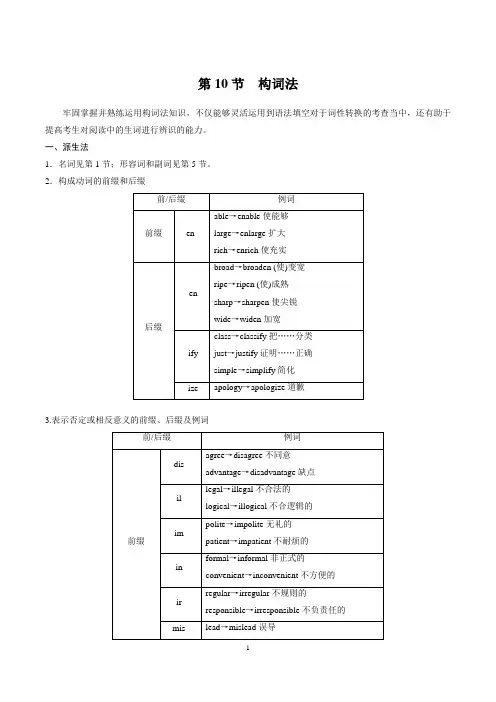
第10节构词法牢固掌握并熟练运用构词法知识,不仅能够灵活运用到语法填空对于词性转换的考查当中,还有助于提高考生对阅读中的生词进行辨识的能力。
一、派生法1.名词见第1节;形容词和副词见第5节。
2.构成动词的前缀和后缀3.表示否定或相反意义的前缀、后缀及例词二、合成法和转化法1.合成法合成词是由两个或两个以上的词合成一个新词的构词方式(有的合成词写在一起,有的中间需加连字符,有的是分开写的两个)。
合成词的词义可以根据各个组成部分的意思加以推断。
构成合成词的几个词可以是词性相同的词也可以是词性不同的词。
高中阶段常见的合成形式有:2.转化法不增加任何成分,不改变词形,把一个单词由一种词性转化为另外一种词性的构词法叫转化法。
常见的转化形式有:Ⅰ.单句语法填空1.Toavoidkneepain,youcanrunonsoftsurfaces,doexercisesto(strength) yourlegmuscles(肌肉),avoidhillsandgetgoodrunningshoes.(2018·全国Ⅰ)答案strengthen解析此处表示做运动的目的,再根据后面的宾语“yourlegmuscles”判断此处应该用及物动词strengthen。
2.Mostpubshavenowaiters—youhavetogotothebar(吧台) tobuydrinks.Thismaysound(convenient),butEnglishpeopleareusedtodoingso.答案inconvenient解析这里指的是没有服务生为顾客服务是不方便的,所以在系动词sound后,用convenient的反义词形式。
3.Thirdly,therearesomereferencebookswithmanymistakes,whichmight(lead) students.答案mislead解析根据语境中的“withmanymistakes”可知,这些错误百出的参考书有可能误导学生,故用lead的反义词,且位于情态动词might后,要用动词原形,故填mislead。
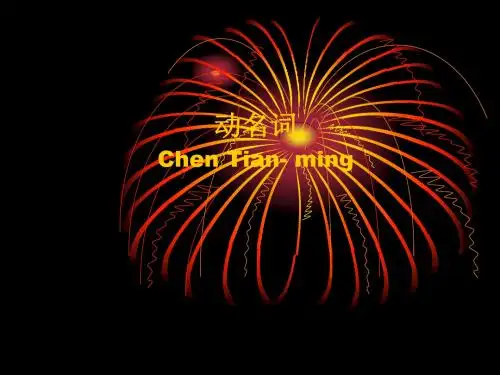
2019年高考英语语法必考考点(1):名词含解析李仕才【考点解读】研究近年来高考题我们不难看出,名词部分主要考察名词的词义辨析和习惯搭配、名词的数(可数与不可数、单数与复数)、名词的所有格、抽象名词的具体化、物质名词的量化、词性转换、名词和冠词的搭配以及主谓一致等。
在高考试题中,名词常结合其他项目一起考察,考察题型以短文改错、完形填空、语篇中的名词词义理解、单项选择、及写作部分等。
对名词的考察一般放在名词词义辨析(特别是同义词和近义词的辨析)、名词的习惯用法、一词多义、抽象名词具体化、词性转换、名词动用等方面。
1、对同义词、近义词的考查如:At the meeting they discussed three different _______ to the study of mathematics.A. approachesB. meansC. methodsD. ways【答案】D。
【解析】在会议上他们讨论了三种不同的学习数学的方法。
way意为“方式,方法”,可指具体的方法,也可指抽象的方法,多指一般的思想、行动、办事的方法,也可指个人特殊的方式、方法。
approach意为“接近,靠近,方式,方法”,指接近某人或某事,也可指对待或处理事情的方式或方法。
mean意为“方式,方法”,用于抽象意义,可指为达到某一目的而采用的方法、计划、政策、策略等,尤指整套方法;用于具体意义,常指为达到某一目的所使用的工具、材料、机器、用具、车船等。
method意为“方式,方法”,指具体的、系统的、有步骤的方法,强调条理性及高效率。
【点睛】面对英语学习中的大量近义词,仅凭母语我们往往无法把它们真正理解和解释清楚。
要尽可能地多翻阅英语词典,注意并比较它们的基本义,用英语的思维方式和语言来解释和理解它们。
2、对相似词的考查如:Always read the _______ on the bottle carefully and take the right amount of medicine.A. explanationsB. instructionsC. descriptionsD. introductions【答案】B。
高中英语语法知识汇编第一章:基本知识一.简单句的五种基本结构英语句子的基本结构可以归纳成五种基本句型及其扩大、组合、省略或倒装。
掌握这五种基本句型,是掌握各种英语句子结构的基础。
英语五种基本句型列式如下:一:SV(主+谓)二:SVP(主+系+表)三:SVO(主+谓+宾)四:SVoO(主+谓+间宾+直宾)五:SVOC(主+谓+宾+宾补)基本句型一:SV(主+谓)It is raining now.We've worked for 5 hours.The meeting lasted half an hour.Time flies.基本句型二:SVP(主+系+表)系动词主要是be. 但还有一些动词在有些时候也可作系动词,有人称之为半系动词。
常见的半系动词有:(1)表示特征和存在状态的be, seem, feel, appear, look, smell, taste, sound等;(2)表示状态延续的remain, stay, keep, continue, stand等;(3)表示状态变化的become, get, turn, go, run, fall, come, grow等。
系动词不能单独作谓语,要和表语一起作谓语He is a student.Your idea sounds great.基本句型三:SVO(主+谓+宾)此结构是由“主语+及物动词(词组)+宾语”构成。
She likes English.We planted a lot of trees on the farm yesterday.基本句型四:SVoO(主+谓+间宾+直宾)一般的顺序为:动词+ 间接宾语+ 直接宾语。
如:He give me a cup of tea. (SVoO)He sent me an English-Chinese Dictionary.= He sent an English-Chinese Dictionary to me.She gave John a book.= She bought a book for me.基本句型五:SVOC(主+谓+宾+宾补)此句型的句子的特点是:动词虽然是及物动词,但是只跟一个宾语还不能表完整的意思,必须加上一个补充成分来补足宾语,才能使意思完整。
宾语补语:位于宾语之后对宾语做出说明的成分。
宾语与其补足语有逻辑上的主谓系,它们一起构成复合宾语。
The war made him a soldier.New methods make the job easy.I often find him at work.The teacher asked the students to close the windows.I saw a cat running across the road.句子种类:1)简单句:只有一个主语(或并列主语)和一个谓语(或并列谓语)。
e.g. He often reads English in the morning.Tom and Mike are American boys.She likes drawing and often draws pictures for the wall newspapers.2) 并列句:由并列连词(and, but, or等)或分号(;)把两个或两个以上的简单句连在一起构成。
要注意哟,逗号是不可以连接句子的,这一点和汉语不同.1、连接两个同等概念。
The teacher’s name is Smith, and the student’s name is John.2、表示选择。
Hurry up, or you’ll miss the train.3、表示转折。
He was a little man with thick glasses, but he had a strange way ofmaking his classes lively and interesting.4、表示因果关系August is the time of the year for rice harvest, so every day I work from dawn until dark.3)复合句:当简单句的一个成分从词或词组变为句子时,整个句子就成为复合句了。
1.It is wrong. (只有一个主谓结构,是简单句)What he said is wrong.2.The boy over there is my brother.3.The boy who is wearing a hat is my brother.4.I was doing my homework at six.I was doing my homework when he came in.考点:两个主谓结构时,要用连接词,变为并列句或复合句判断正误I like English, my English is very good.()I like English and my English is very good.()As I like English, my English is very good. ()I have a house, its windows are very big. ()I have a house and its windows are very big. ()I have a house, whose windows are very big. ()试真题单句改错1 Though not very big, but the restaurant is popular in our area.2 If we stay at home, it is comfortable but there is no need to spend money.3 Mom has a full-time job, so she has to do most of the housework.4 There the air is clean or the mountain are green.5 A passenger realized he couldn’t find his ticket but became quite upset.6 If you notice that someone is missing and hurt, tell your teacher单句填空.1 It was time for her to have a new baby,_____ it was also time for the young panda to be independent.2 He is a shy man, ____ he is not afraid of anything or anyone.3 But the river wasn’t changed in a few days ____ even a few m onths.4 Give me a chance ,____ I will give you a wonderful surprise.5 It is not easy to change habits,____ with awareness and self-control , it is possible.第二章名词考纲解读:掌握高考常考名词的词义及其单复数形式,并能在具体语境中灵活运用命题趋势:1 语法填空主要考查学生对句子结构的理解,根据名词的地位和作用,对所给单词的进行名词及名词的格的转换,或根据数量要求考查名词的单复数形式。
名词可以分为专有名词和普通名词,专有名词是某个(些)人,地方,机构等专有的名称,如Beijing,China等。
普通名词是一类人或东西或是一个抽象概念的名词,如:book,sadness等。
普通名词又可分为下面四类:1)个体名词:表示某类人或东西中的个体,如:gun。
2)集体名词:表示若干个个体组成的集合体,如:family。
3)物质名词:表示无法分为个体的实物,如:air。
4)抽象名词:表示动作、状态、品质、感情等抽象概念,如:work。
个体名词和集体名词可以用数目来计算,称为可数名词,物质名词和抽象名词一般无法用数目计算,称为不可数名词。
1.1 名词复数的规则变化情况构成方法读音例词一般情况加-s 清辅音后读/s/ map-maps浊辅音和元音后读/z/ bag-bags /car-cars以s, sh, ch, x等结尾加-es 读/iz/ bus-buses/ watch-watches以ce, se, ze,等结尾加-s 读/iz/ license-licenses以辅音字母+y结尾变y 为i再加es 读/z/ baby---babies1.2 其它名词复数的规则变化1)以y结尾的专有名词,或元音字母+y 结尾的名词变复数时,直接加s变复数。
如:two Marys the Henrysmonkey---monkeys holiday---holidays2)以o 结尾的名词,变复数时:a. 加s,如:photo---photos piano---pianosradio---radios zoo---zoos;b. 加es,如:potato--potatoes tomato--tomatoesc. 上述a和b两种方法均可,如zero---zeros / zeroes。
3)以f或fe 结尾的名词ZYB可调式渣油泵变复数时:a. 加s,如:belief---beliefs roof---roofssafe---safes gulf---gulfs;b. 去f, fe 加ves,如:half---halvesknife---knives leaf---leaves wolf---wolveswife---wives life---lives thief---thieves;c. 上述a和b两种方法均可,如handkerchief: handkerchiefs / handkerchieves。
1.3 名词复数的不规则变化1)child---children foot---feet tooth---teethmouse---mice man---men woman---women注意:由一个词加man 或woman构成的合成词,其复数形式也是-men 和-women,如an Englishman,two Englishmen。
但German不是合成词,故复数形式为Germans;Bowman是姓,其复数是the Bow mans。